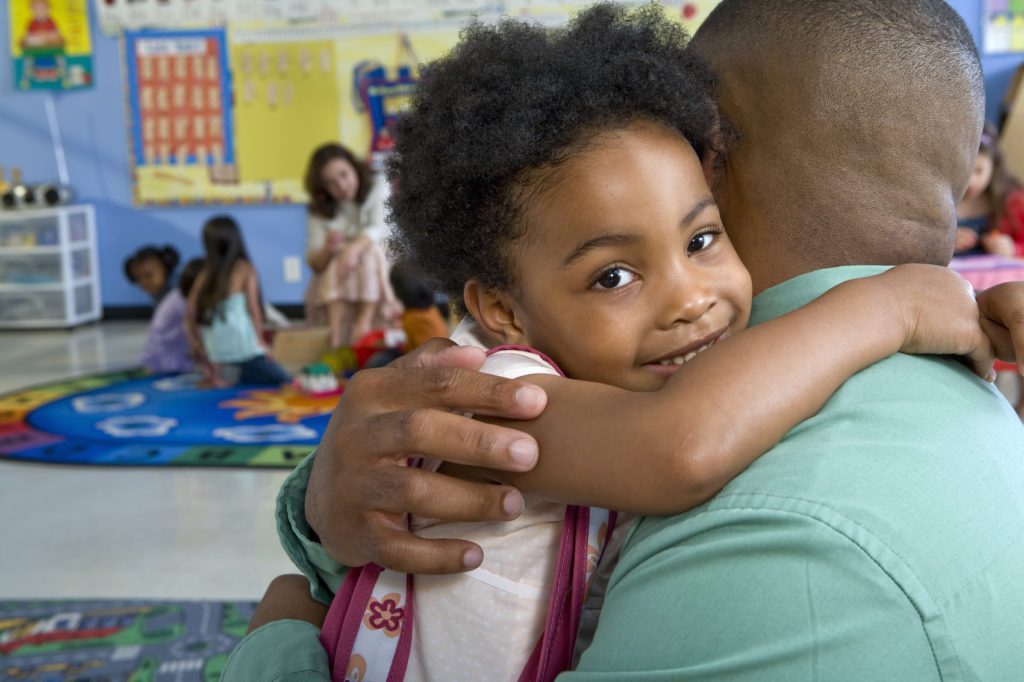The First Six Weeks of School: Greeting Children & Families

How will you help children and families feel welcome in their new learning community on the first day?
It could be said that love is the launchpad to learning, and that feeling welcome is the fuel that propels the rocket. In my former life as a teacher, the first weeks of school always felt like one endless Sunday night spent on preparations. Now as a coach and mentor, I am supporting teachers with open houses and home visits as we introduce or reintroduce ourselves to children and their families.
One resource I turn to in my coaching/mentoring role is The Creative Curriculum for Preschool. Chapter 4 in “Volume 1: The Foundation” offers excellent guidance for building positive, loving relationships with children and welcoming them into our programs. For example, it emphasizes the value of allowing plenty of time for hellos and goodbyes and of keeping initial group meetings short. In those early days and weeks, some children might participate by watching group meetings from a comfortable distance, so it’s important to stay flexible and understand that some children might not yet be ready to participate. Each day is a brand-new day to a 3-year-old, so keep in mind that young children might not retain what you say from day to day or even most of what you say. It helps to get comfortable with feeling—and sounding—like a broken record as you repeat directions and explanations again and again. But take heart: There are ways to get children’s attention when it begins to dwindle. I use a signal in the form of a statement: “If you can hear my voice, take a deep breath.” When you find yourself in similar circumstances, you can think of your own special statement, song, rhyme, or movement to get children’s attention back on track.
Many teachers also seek ideas for making children’s families feel welcome from the moment they enter the classroom on the first day of school. Chapter 5 of Volume 1 suggests getting to know families by making your entranceway inviting. I had a big, comfy, adult-sized chair near my sign-in sheet and provided a place for families to hang up their coats so they could stay a while.
Another great resource for teachers starting a new school year is The Hub, an Early Childhood Education Professional Learning Community. The Hub provides a much-needed space for teachers to come together to share ideas and get support from their greatest allies: other teachers. As we prepare to meet new children and families this year, this group provides accountability partners that help everyone put all those tools and resources from Teaching Strategies into use in their classrooms right away.
Teachers on The Hub have recently been discussing their experiences with helping children and families feel welcome in their new learning community on the first day. Today, we are highlighting some of our favorite ideas that our teacher colleagues shared this week. Here are some golden nuggets of knowledge from this week’s forums:
Two small things come to mind that can go a long way. Try to find at least one time during the day you can interact with each child individually, talk to them, read to them, show interest in what they are doing. For parents I try to find one positive thing I can tell them about their child at the end of the day. In the beginning I actually wrote it down so I wouldn’t forget by the evening, “Susie shared her toy today”, “Ben pedaled his bike! Yesterday he was pushing forward with his feet” and so on. This also helps you as the teacher because you are training yourself to look for the positive instead of the negative behaviors.
Regina G.
Missouri
Day #1 is so important in developing relationships with the children and their families. We have a drop-in day where the caregivers can come with their child to see the classroom prior to the first day. This allows the children to see the environment while having the safety of an adult. My goal is to have them feel safe and to know that I am there to help them with all their needs.
Cheryl W.
Illinois
We encourage families to participate in as many ways as possible, this may include sending in pictures about what the have done at home, having them donate items for the different activities we are doing. For example, the parents were very eager to let us borrow camping supplies and materials. They also are excited to let the class borrow books during the week that align with the study or theme we are using. It keeps the parents involved without having to physically be in the classroom. They love it and so do the children!
Jessica D.
Virginia
“I think the message that I want to send to my children and family is a sense of welcoming, belonging and engaging. I want them to know that our doors are open and as long as everyone is engage in the process, the children will be okay.”
Anthony L.
New York
Every child and every community are unique, and the ways we make children and families feel welcome may vary from school to school and family to family. No matter how you are doing it, putting the time and effort into building these relationships with families now will benefit you all year long.

Interested in joining the conversation?
Teachers with access to the Teaching Strategies platform can join conversations with other educators in The Hub’s First Six Weeks Forum.